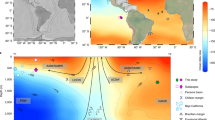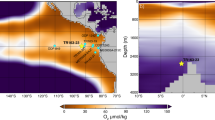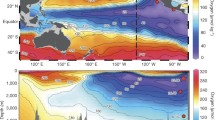Abstract
Several modelling and observational studies suggest deep water formation in the subpolar North Pacific as a possible alternative mode of thermohaline circulation that occurred in the warm Pliocene, a time when global atmospheric partial pressure of carbon dioxide was like the modern atmosphere (~400 ppm). We test this hypothesis by measuring the δ13C of the benthic foraminifer Cibicidoides wuellerstorfi collected from northernmost Pacific mid-Piacenzian Warm Period (3.264–3.025 Myr ago) sediments. The data reveal progressively more isotopically negative dissolved inorganic carbon along a northward Equator-to-pole transect, the opposite of the expected Pliocene Pacific meridional overturning circulation signal. C. wuellerstorfi δ13C is also often more positive at the deeper Ocean Drilling Program (ODP) site 887 compared with the shallower ODP site 883, suggesting ‘bottom-up’ ventilation of the deep Pacific Ocean. We then present alkenone sea surface temperature and export-productivity data from ODP site 883, which suggest that late Pliocene subarctic North Pacific carbonate sedimentation was, at least in part, probably due to higher coccolithophore export production, rather than North Pacific Deep Water formation as previously argued. Therefore, we suggest it is unlikely that North Pacific Deep Water formation occurred in the mid-Piacenzian Warm Period, although a shallower overturning cell cannot be ruled out.




Similar content being viewed by others
Data availability
All data from sites 883 and 887, calculations, new age models and composite sections generated for this paper are available in Supplementary Data 1. All data are available via PANGAEA at https://doi.org/10.1594/PANGAEA.967342 (ref. 73) and via figshare at https://doi.org/10.6084/m9.figshare.25066535 (ref. 74). References to published C. wuellerstorfi stable isotope datasets are available in Supplementary Table 2. Source data are provided with this paper.
Change history
13 August 2024
In the version of this article initially published, the Extended Data Fig. 1 legend featured some obsolete figure description which is now removed from the HTML and PDF versions of the article.
References
Sigman, D. M., Hain, M. P. & Haug, G. H. The polar ocean and glacial cycles in atmospheric CO2 concentration. Nature 466, 47–55 (2010).
Rafter, P. A. et al. Global reorganization of deep-sea circulation and carbon storage after the last ice age. Sci. Adv. 8, eabq5434 (2022).
Hoogakker, B. A. A. et al. Glacial expansion of oxygen-depleted seawater in the eastern tropical Pacific. Nature 562, 410–413 (2018).
Jacobel, A. W. et al. Deep Pacific storage of respired carbon during the last ice age: perspectives from bottom water oxygen reconstructions. Quat. Sci. Rev. 230, 106065 (2020).
Anderson, R. F. et al. Deep‐sea oxygen depletion and ocean carbon sequestration during the last ice age. Glob. Biogeochem. Cycles 33, 301–317 (2019).
Ford, H. L. et al. Sustained mid-Pliocene warmth led to deep water formation in the North Pacific. Nat. Geosci. 15, 658–663 (2022).
Haywood, A. M. et al. The Pliocene Model Intercomparison Project Phase 2: large-scale climate features and climate sensitivity. Climate 16, 2095–2123 (2020).
McClymont, E. L. et al. Lessons from a high-CO2 world: an ocean view from ∼3 million years ago. Climate 16, 1599–1615 (2020).
Tierney, J. E. et al. Past climates inform our future. Science 370, eaay3701 (2020).
Haywood, A. M., Dowsett, H. J. & Dolan, A. M. Integrating geological archives and climate models for the mid-Pliocene warm period. Nat. Commun. 7, 10646 (2016).
Burls, N. J. et al. Simulating Miocene warmth: insights from an opportunistic multi-model ensemble (MioMIP1). Paleoceanogr. Paleoclimatol. 36, e2020PA004054 (2021).
Huber, M. & Caballero, R. The early Eocene equable climate problem revisited. Climate 7, 603–633 (2011).
Burls, N. J. & Fedorov, A. V. Simulating Pliocene warmth and a permanent El Niño-like state: the role of cloud albedo. Paleoceanography 29, 893–910 (2014).
Kiehl, J. T. & Shields, C. A. Sensitivity of the Palaeocene–Eocene Thermal Maximum climate to cloud properties. Phil. Trans. R. Soc. A 371, 20130093 (2013).
Burls, N. J. & Fedorov, A. V. Wetter subtropics in a warmer world: contrasting past and future hydrological cycles. Proc. Natl Acad. Sci. USA 114, 12888–12893 (2017).
Burls, N. J. et al. Active Pacific meridional overturning circulation (PMOC) during the warm Pliocene. Sci. Adv. 3, e1700156 (2017).
Schmittner, A. et al. Calibration of the carbon isotope composition (δ13C) of benthic foraminifera. Paleoceanography 32, 512–530 (2017).
Kroopnick, P. M. The distribution of 13C of ΣCO2 in the world oceans. Deep Sea Res. A 32, 57–84 (1985).
Sigman, D. M. & Boyle, E. A. Glacial/interglacial variations in atmospheric carbon dioxide. Nature 407, 859–869 (2000).
Olsen, A. et al. The Global Ocean Data Analysis Project version 2 (GLODAPv2) - an internally consistent data product for the world ocean. Earth Syst. Sci. Data 8, 297–323 (2016).
Galbraith, E. D., Kwon, E. Y., Bianchi, D., Hain, M. P. & Sarmiento, J. L. The impact of atmospheric CO2 on carbon isotope ratios of the atmosphere and ocean. Glob. Biogeochem. Cycles 29, 307–324 (2015).
Eggleston, S. & Galbraith, E. D. The devil’s in the disequilibrium: multi-component analysis of dissolved carbon and oxygen changes under a broad range of forcings in a general circulation model. Biogeosciences 15, 3761–3777 (2018).
Mook, W. G., Bommerson, J. C. & Staverman, W. H. Carbon isotope fractionation between dissolved bicarbonate and gaseous carbon dioxide. Earth Planet. Sci. Lett. 22, 169–176 (1974).
Lynch‐Stieglitz, J., Stocker, T. F., Broecker, W. S. & Fairbanks, R. G. The influence of air–sea exchange on the isotopic composition of oceanic carbon: observations and modeling. Glob. Biogeochem. Cycles 9, 653–665 (1995).
Mackensen, A., Hubberten, H.-W., Bickert, T., Fischer, G. & Fütterer, D. K. The δ13C in benthic foraminiferal tests of Fontbotia wuellerstorfi (Schwager) relative to the δ13C of dissolved inorganic carbon in Southern Ocean deep water: implications for glacial ocean circulation models. Paleoceanography 8, 587–610 (1993).
Ebisuzaki, W. A method to estimate the statistical significance of a correlation when the data are serially correlated. J. Clim. 10, 2147–2153 (1997).
Feng, H., Tian, J., Lyle, M., Westerhold, T. & Wilkens, R. High resolution benthic foraminiferal δ18O and δ13C records at ODP site 807 over the past 5 Ma, Ontong Java Plateau: evolution of North Pacific ventilation, Pliocene to Holocene. Glob. Planet. Change 217, 103945 (2022).
Karas, C. et al. Mid-Pliocene climate change amplified by a switch in Indonesian subsurface throughflow. Nat. Geosci. 2, 434–438 (2009).
Talley, L. D. Closure of the global overturning circulation through the Indian, Pacific, and Southern Oceans: schematics and transports. Oceanography 26, 80–97 (2013).
Chen, T., Liu, Q. & Wang, X. Enhanced direct ventilation in the subarctic Pacific Ocean during 3.5–2.73 Ma: new evidence of elemental results from ODP site 882. Glob. Planet. Change 215, 103867 (2022).
Dowsett, H. J. & Ishman, S. E. Middle Pliocene planktonic and benthic foraminifers from the subarctic North Pacific: sites 883 and 887. Proc. ODP Sci. Res. 145, 141–156 (1992).
Jaccard, S. L. & Galbraith, E. D. Large climate-driven changes of oceanic oxygen concentrations during the last deglaciation. Nat. Geosci. 5, 151–156 (2012).
Lisiecki, L. E. & Raymo, M. E. A Pliocene–Pleistocene stack of 57 globally distributed benthic δ18O records. Paleoceanography 20, PA1003 (2005).
Kawabe, M. & Fujio, S. Pacific Ocean circulation based on observation. J. Oceanogr. 66, 389–403 (2010).
Peterson, C. D. & Lisiecki, L. E. Deglacial carbon cycle changes observed in a compilation of 127 benthic δ13C time series (20–6 ka). Climate 14, 1229–1252 (2018).
Jian, Z. et al. Changes in deep Pacific circulation and carbon storage during the Pliocene–Pleistocene transition. Earth Planet. Sci. Lett. 605, 118020 (2023).
de la Vega, E., Chalk, T. B., Wilson, P. A., Bysani, R. P. & Foster, G. L. Atmospheric CO2 during the Mid-Piacenzian Warm Period and the M2 glaciation. Sci. Rep. 10, 14–21 (2020).
Haug, G. H., Sigman, D. M., Tiedemann, R., Pedersen, T. F. & Sarnthein, M. Onset of permanent stratification in the subarctic Pacific Ocean. Nature 401, 779–782 (1999).
Rea, D. K., Basov, I. A., Janecek, T. R., Palmer-Julson, A. & Shipboard Scientific Party. Initial report: site 882. Proc. ODP Init. Rep. https://doi.org/10.2973/odp.proc.ir.145.106.1993 (1993).
Haug, G. H., Maslin, M. A., Sarnthein, M., Stax, R. & Tiedemann, R. Evolution of northwest Pacific sedimentation patterns since 6 Ma (site 882). Proc. ODP Sci. Res. 145, 293–314 (1995).
Marlowe, I. T., Brassell, S. C., Eglinton, G. & Green, J. C. Long chain unsaturated ketones and esters in living algae and marine sediments. Org. Geochem. 6, 135–141 (1984).
Bolton, C. T. et al. Glacial–interglacial productivity changes recorded by alkenones and microfossils in late Pliocene eastern equatorial Pacific and Atlantic upwelling zones. Earth Planet. Sci. Lett. 295, 401–411 (2010).
Haug, G. H. et al. North Pacific seasonality and the glaciation of North America 2.7 million years ago. Nature 433, 821–825 (2005).
Studer, A. S. et al. Enhanced stratification and seasonality in the subarctic Pacific upon Northern Hemisphere glaciation—new evidence from diatom-bound nitrogen isotopes, alkenones and archaeal tetraethers. Earth Planet. Sci. Lett. 351–352, 84–94 (2012).
Lamy, F. et al. Five million years of Antarctic Circumpolar Current strength variability. Nature 627, 789–796 (2024).
Rae, J. W. B. et al. Overturning circulation, nutrient limitation, and warming in the glacial North Pacific. Sci. Adv. 6, eabd1654 (2020).
Abell, J. T. & Winckler, G. Long‐term variability in Pliocene North Pacific Ocean export production and its implications for ocean circulation in a warmer world. AGU Adv. 4, e2022AV000853 (2023).
Kemp, A. E. S. & Villareal, T. A. High diatom production and export in stratified waters – a potential negative feedback to global warming. Prog. Oceanogr. 119, 4–23 (2013).
Pawlowicz, R. M_Map: a mapping package for MATLAB, version 1.4m (2020); https://www.eoas.ubc.ca/~rich/map.html
Ahn, S., Khider, D., Lisiecki, L. E. & Lawrence, C. E. A probabilistic Pliocene–Pleistocene stack of benthic δ18O using a profile hidden Markov model. Dyn. Stat. Clim. Syst. 2, dzx002 (2017).
Rea, D. K., Basov, I. A., Janecek, T. R., Palmer-Julson, A. & Shipboard Scientific Party. Initial report: site 883. Proc. ODP Init. Rep. 145, 121–208 (1993).
Meyers, S. R. astrochron: A Computational Tool for Astrochronology http://cran.r-project.org/package=astrochron (2014).
Rea, D. K., Basov, I. A., Janecek, T. R., Palmer-Julson, A. & Shipboard Scientific Party. Initial report: site 887. Proc. ODP Init. Rep. 145, 335–391 (1993).
Tiedemann, R. & Haug, G. H. Astronomical calibration of cycle stratigraphy for site 882 in the northwest Pacific. Proc. ODP Sci. Res. 145, 283–292 (1995).
Shackleton, N. J. & Opdyke, N. D. Oxygen isotope and palaeomagnetic stratigraphy of equatorial Pacific core V28-238: oxygen isotope temperatures and ice volumes on a 105 year and 106 year scale. Quat. Res. 3, 39–55 (1973).
Kranner, M., Harzhauser, M., Beer, C., Auer, G. & Piller, W. E. Calculating dissolved marine oxygen values based on an enhanced benthic foraminifera oxygen index. Sci. Rep. 12, 1376 (2022).
Kaiho, K. Benthic foraminiferal dissolved-oxygen index and dissolved-oxygen levels in the modern ocean. Geology 22, 719–722 (1994).
Raja, M. & Rosell-Melé, A. Appraisal of sedimentary alkenones for the quantitative reconstruction of phytoplankton biomass. Proc. Natl Acad. Sci. USA 118, e2014787118 (2021).
Tierney, J. E. & Tingley, M. P. BAYSPLINE: a new calibration for the alkenone paleothermometer. Paleoceanogr. Paleoclimatol. 33, 281–301 (2018).
Keigwin, L. D. Glacial-age hydrography of the far northwest Pacific Ocean. Paleoceanography 13, 323–339 (1998).
Caballero-Gill, R. P., Herbert, T. D. & Dowsett, H. J. 100-kyr paced climate change in the Pliocene Warm Period, southwest Pacific. Paleoceanogr. Paleoclimatol. 34, 524–545 (2019).
Patterson, M. O. et al. A southwest Pacific perspective on long-term global trends in Pliocene–Pleistocene stable isotope records. Paleoceanogr. Paleoclimatol. 33, 825–839 (2018).
Tian, J., Wang, P., Cheng, X. & Li, Q. Astronomically tuned Plio–Pleistocene benthic δ18O record from South China Sea and Atlantic–Pacific comparison. Earth Planet. Sci. Lett. 203, 1015–1029 (2002).
Jian, Z. et al. Pliocene–Pleistocene stable isotope and paleoceanographic changes in the northern South China Sea. Palaeogeogr. Palaeoclimatol. Palaeoecol. 193, 425–442 (2003).
Herbert, T. D., Peterson, L. C., Lawrence, K. T. & Liu, Z. Tropical ocean temperatures over the past 3.5 million years. Science 328, 1530–1534 (2010).
Herbert, T. D., Caballero-Gill, R. & Novak, J. B. A revised mid-Pliocene composite section centered on the M2 glacial event for ODP site 846. Climate 17, 1385–1394 (2021).
Tierney, J. E., Haywood, A. M., Feng, R., Bhattacharya, T. & Otto-Bliesner, B. L. Pliocene warmth consistent with greenhouse gas forcing. Geophys. Res. Lett. 46, 9136–9144 (2019).
York, D., Evensen, N. M., Martı́nez, M. L. & De Basabe Delgado, J. Unified equations for the slope, intercept, and standard errors of the best straight line. Am. J. Phys. 72, 367–375 (2004).
York, D. Least squares fitting of a straight line with correlated errors. Earth Planet. Sci. Lett. 5, 320–324 (1968).
Wehr, R. & Saleska, S. R. The long-solved problem of the best-fit straight line: application to isotopic mixing lines. Biogeosciences 14, 17–29 (2017).
Mahon, K. I. The new ‘York’ regression: application of an improved statistical method to geochemistry. Int. Geol. Rev. 38, 293–303 (1996).
Müller, P. J., Kirst, G., Ruhland, G., Von Storch, I. & Rosell-Melé, A. Calibration of the alkenone paleotemperature index U37K′ based on core-tops from the eastern South Atlantic and the global ocean (60° N–60° S). Geochim. Cosmochim. Acta 62, 1757–1772 (1998).
Novak, J., Caballero-Gill, R. P., Rose, R., Herbert, T. D. & Dowsett, H. J. Multiproxy paleoceanogrpahic dataset from ODP site 883 and 887 and compiled mid Piacenzian benthic foraminiferal stable carbon isotope data from 23 IODP/ODP/DSDP sites. PANGAEA https://doi.org/10.1594/PANGAEA.967342 (2024).
Novak, J., Caballero-Gill, R. P., Rose, R., Herbert, T. D. & Dowsett, H. J. Data from ODP Leg 145 Sites 883, 887, compiled MPWP benthic stable carbon isotopes, and example code. figshare https://doi.org/10.6084/m9.figshare.25066535 (2024).
Acknowledgements
We thank A. Tzanova, A. Martin, K. Zimmerman and S. Clemens for their support analysing samples at Brown University. We thank B. Dreyer for support analysing samples in the Marine Analytical Laboratory at the University of California, Santa Cruz. We thank N. J. Burls for providing the model output from ref. 6. J.B.N. thanks K. Delong, A. C. Ravelo, P. J. Polissar, K. Thirumalai and J. T. Abell for helpful discussions and guidance on North Pacific palaeoceanography and stratigraphic correlation. J.B.N. thanks P. Daniel for coding support. R.P.C.-G. thanks the GeoLatinas impetu community for co-working and co-writing support. This research used samples and data provided by the International Ocean Discovery Program (IODP). This work was funded by the National Science Foundation through grants 1545859 (T.D.H.), 1459280 (T.D.H.) and 1602331 (T.D.H.) and the US Geological Survey Climate R&D Program (H.J.D.). Any use of trade, firm or product names is for descriptive purposes only and does not imply the endorsement of the US Government.
Author information
Authors and Affiliations
Contributions
J.B.N. wrote the original manuscript. J.B.N., R.P.C.-G., R.M.R., T.D.H. and H.J.D. edited and refined the final paper draft. R.P.C.-G., R.M.R. and J.B.N. conducted sample analyses. J.B.N., R.P.C.-G. and T.D.H. collectively worked on the stratigraphy and age model. J.B.N. analysed the data and compiled published datasets. T.D.H. was the principal investigator. R.P.C.-G., T.D.H. and H.J.D. designed the experiment. T.D.H. and H.J.D. procured the funding that supported this project.
Corresponding author
Ethics declarations
Competing interests
The authors declare no competing interests.
Peer review
Peer review information
Nature Geoscience thanks William Gray, Patrick Rafter, Hongrui Zhang and the other, anonymous, reviewer(s) for their contribution to the peer review of this work. Primary Handling Editors: Alireza Bahadori and James Super, in collaboration with the Nature Geoscience team.
Additional information
Publisher’s note Springer Nature remains neutral with regard to jurisdictional claims in published maps and institutional affiliations.
Extended data
Extended Data Fig. 1 Section plots of West and East Pacific mean MIS KM5 C. wuellerstorfi δ13C.
(a) West Pacific data. (b) East Pacific data.
Supplementary information
Supplementary Information
Supplementary Text 1.1–1.4, Figs. 1–9 and Tables 1 and 2.
Supplementary Code 1
Example code for the random resampling technique used to estimate uncertainty in our deep ocean δ13CDIC stacks.
Supplementary Data 1
All new and compiled data associated with the paper, including splice tables, age models and additional notes on their use.
Source data
Source Data 1
Western North Pacific benthic stable carbon isotope data and core-top anomalies.
Source Data 2
Benthic stable carbon isotope data compiled from 23 DSDP/ODP/IODP drill sites.
Source Data 3
Estimated deep Pacific and deep Atlantic δ13CDIC and Δδ13CDIC.
Source Data 4
Alkenone and calcium carbonate mass accumulation rate data from ODP 883. Biogenic opal and calcium carbonate mass accumulation rate data from ODP 882. C. wuellerstorfi B/Ca-inferred Δ[CO32−] from IODP U1489. Alkenone SSTs from ODP 883 and 882.
Source Data 5
Benthic stable carbon isotope data from the western and eastern North Pacific.
Rights and permissions
Springer Nature or its licensor (e.g. a society or other partner) holds exclusive rights to this article under a publishing agreement with the author(s) or other rightsholder(s); author self-archiving of the accepted manuscript version of this article is solely governed by the terms of such publishing agreement and applicable law.
About this article
Cite this article
Novak, J.B., Caballero-Gill, R.P., Rose, R.M. et al. Isotopic evidence against North Pacific Deep Water formation during late Pliocene warmth. Nat. Geosci. 17, 795–802 (2024). https://doi.org/10.1038/s41561-024-01500-7
Received:
Accepted:
Published:
Issue Date:
DOI: https://doi.org/10.1038/s41561-024-01500-7
- Springer Nature Limited





